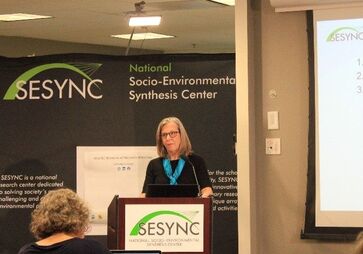 Dr. Margaret Palmer giving a presentation about SESYNC. Dr. Margaret Palmer giving a presentation about SESYNC. written by: Max Ferlauto, MS student, Burghardt Lab In this anthropogenic age, most natural, social, and economic systems are tightly linked. However, scholars studying these systems tend to be isolated by their respective disciplines. It is the role of the National Socio-Environmental Synthesis Center (SESYNC) to bridge this divide. SESYNC, located in Annapolis, MD, is one of four Synthesis Centers that have been funded by the National Science Foundation (NSF). Synthesis Centers facilitate team research to generate discoveries from existing data, addressing fundamental questions and leading to innovative solutions. What sets SESYNC apart from other Synthesis Centers is its focus on linking natural and social science together. The idea came about in 2010 at a small workshop during a discussion about the NSF’s call for a new Synthesis Center. Margaret Palmer, Bill Fagan – both professors at the University of Maryland, and Jonathan Kramer, the then director of the Maryland Sea Grant, decided that the new center needed to study socio-environmental not just ecological science. Palmer and Kramer, joined by ecological economist Jim Boyd, spent almost a year drafting the proposal. Their effort paid off and the NSF provided funding for SESYNC in 2011. Actionable Science SESYNC has the scientific goal to promote synthetic, actionable research. This means using existing data to produce research that is relevant to the decisions and behaviors of non-scientific audiences such as non-profits, governments, and even the wider public. Addressing the UMD Entomology Department at our weekly seminar, Margaret Palmer made clear that SESYNC does not just support applied research. Rather, it supports what she calls actionable fundamental research – namely, research focused on questions that have relevance to multiple places or points in time. For example, applied research by a consulting firm may tell you how to “fix” the water quality problems in the Chesapeake, while SESYNC research would inform solutions to social and environmental problems associated with coastal eutrophication more generally. To do this, SESYNC offers support for accommodation and travel to convene interdisciplinary teams of scientists. SESYNC also offers computational resources, team science expertise, and a variety of short courses and communications support. Interestingly, unlike NSF grants, submitting proposals to SESYNC involves discussion and feedback throughout the process. Therefore, most projects are funded with the understanding of iteration and improvement. Examples of past research include studying how ecosystem services reflect phylogenetic relationships, analyzing how extreme weather events motivate behavior change that influence carbon emissions, and developing new methods to help the U.S. Fish and Wildlife Service prioritize spending on endangered species. Capacity Building
SESYNC also has the social goal of building capacity. Capacity building involves building new communities of scholars who are prepared to undertake socio-environmental research, coordinating collaboration with potential stakeholders, and providing training in interdisciplinary research. SESYNC’s training programs include 2-5 day “Socio-environmental Immersion” workshops, in which experts from diverse disciplines teach the fundamental theories and methods their field uses to undertake research. SESYNC also provides short courses on everything from writing to Bayesian statistics. Additionally, SESYNC funds a strong doctoral and postdoctoral program in which promising early career researchers partner with an external mentor to conduct cutting-edge team research. Despite resources and opportunities, there are still challenges involved in the collaboration between disciplines. Social and natural scientists use diverse types of data, methodology, and even language. Palmer admitted that SESYNC will never have all the answers to overcoming these challenges, but they developed methods for tackling them based on hypotheses informed by the science of team science, research from organizational science, cognitive psychology, and other relevant bodies of scholarship. In fact, she referred to SESYNC developing its programs and organizational methods experimentally. However, she made clear that they are not focused on creating controlled data on social group dynamics as that would interfere with advancing teams quickly towards their goals. Nevertheless, Palmer outlined some lessons they have learned. For example, some solutions to common challenges involve creating shared conceptual models among teams, ensuring that all team members agree on the research strategy, and maintaining continuous communication. SESYNC also encourages innovation by requiring that all research teams have both natural and social scientists. Additionally, at least half of a research team must be new to working together in order to expose researchers to new ideas and ways of working. Palmer also had some more advice, stating, “Good impactful [multidisciplinary] research doesn't just happen, it takes careful preparation and thought.” She elaborated that equality and trust among researchers is key and top down leadership can be the downfall of collaboration. The NSF funds Synthesis Centers for a maximum of 10 years. Therefore, NSF-funding for SESYNC will soon be coming to an end. The center is now shifting into its final phase. It is expanding its reach and Immersion programs as well as leaving capacity building resources, some online in nature. Even though SESYNC itself will not be with us forever, the lessons learned will help multidisciplinary team research continue far into the future. For more Information Website: https://www.sesync.org/ Newsletter Page: https://www.sesync.org/sesync-monthly-newsletter Newsletter Signup: https://visitor.constantcontact.com/d.jsp?m=1112454764165&p=oi Palmer, M. A., Kramer, J. G., Boyd, J., & Hawthorne, D. (2016). Practices for facilitating interdisciplinary synthetic research: the National Socio-Environmental Synthesis Center (SESYNC). Current Opinion in Environmental Sustainability, 19, 111-122. About the Author Max Ferlauto is a master’s student in the Burghardt lab. He studies the effects of suburban leaf litter raking on nutrient cycling and herbivore-parasitoid communities. Comments are closed.
|
Categories
All
Archives
June 2024
|
Department of Entomology
University of Maryland
4112 Plant Sciences Building
College Park, MD 20742-4454
USA
Telephone: 301.405.3911
Fax: 301.314.9290
University of Maryland
4112 Plant Sciences Building
College Park, MD 20742-4454
USA
Telephone: 301.405.3911
Fax: 301.314.9290

 RSS Feed
RSS Feed




